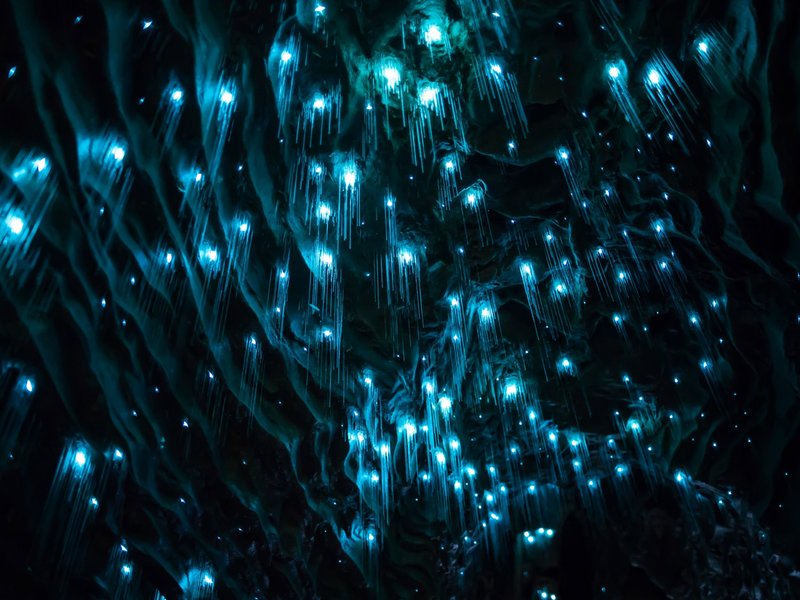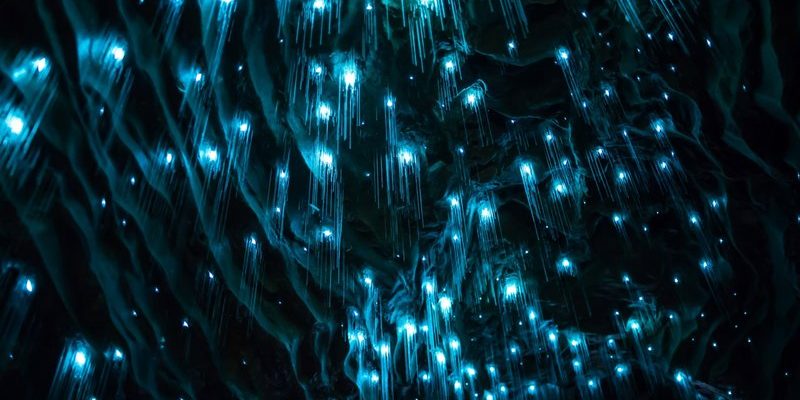
When we think of caves, we often picture silence and solitude. But beneath the surface, it’s bustling with life! From fungi to insects, different species have adapted to this unique environment, creating a diverse and fascinating habitat. Let’s dive into the world of glow worms and their cave companions, exploring how they interact, survive, and contribute to the ecosystem.
What Are Glow Worms?
Glow worms aren’t worms at all. In fact, they’re the larvae of a type of fly, specifically the *Lampyridae* family. These larvae possess a remarkable ability: they emit a soft, blue-green light. This bioluminescence isn’t just for show; it serves a purpose. Glow worms use their light to attract prey, usually small insects that get stuck in silk threads they’ve spun. This clever strategy helps them survive in the dark, nutrient-poor environment of caves.
You might be wondering how this incredible phenomenon works. The light comes from a chemical reaction in the glow worm’s body, specifically involving a pigment called luciferin and an enzyme called luciferase. When the two mix, it produces light without heat—a process known as *cold light*. Imagine having a built-in flashlight that helps you catch your dinner!
Habitat and Distribution
Glow worms are typically found in wet, dark caves around the world. You can find them in places like New Zealand, Australia, and parts of Europe, thriving in areas rich in limestone. These caves often have a stable temperature and humidity, which is essential for their survival.
The cave environment provides a perfect backdrop for glow worms. The dampness keeps their silk threads intact, and the darkness allows them to shine without competition from sunlight. This unique habitat creates an ecosystem where glow worms, along with other cave-dwelling species, can thrive.
Interestingly, glow worms often work in colonies, creating stunning displays of light that can illuminate cave ceilings in breathtaking fashion. It’s like nature’s own light show. But these colonies also depend on the overall health of the cave ecosystem, which brings us to the other species that share their space.
Cave Species That Co-Occur with Glow Worms
Caves might seem like the exclusive domain of glow worms, but they also house many other species that contribute to the ecosystem’s balance. For instance, you’ll find various types of insects, bats, and even unique fungi that play vital roles in maintaining cave life.
Insects such as beetles and spiders often share space with glow worms, creating a mini food web. Bats, for example, are key predators that help control insect populations in the cave. They feed on the very insects that glow worms attract, ensuring that the food chain remains intact.
You might be surprised to learn that fungi also play a crucial role. Some fungi thrive in cave environments, breaking down organic matter and recycling nutrients. They form symbiotic relationships with glow worms, helping to keep the ecosystem healthy while providing essential nutrients through decomposition.
The Relationship Between Glow Worms and Their Cave Environment
The relationship between glow worms and their cave environment is a perfect example of an ecosystem’s delicacy. Glow worms rely heavily on the conditions within the cave. If the humidity drops or pollution increases, it can impact their ability to survive.
These little creatures are indicators of cave health. A thriving population of glow worms usually means the cave is in good condition, while a decline may signal environmental issues. It’s fascinating how interconnected all these cave-dwelling species are, isn’t it? By studying glow worms and their habitats, scientists can gather important information about the broader health of underground ecosystems.
Another element to consider is the impact of human activity. Caves are sometimes threatened by tourism and pollution, which can disrupt the delicate balance. Protecting glow worms and their habitat is crucial for ensuring that these magical creatures continue to thrive in the darkness.
Why Are Glow Worms Important to Ecosystems?
Glow worms are more than just a pretty sight; they contribute significantly to their ecosystems. By controlling insect populations, they help maintain a balance between different species living in the cave. This balance is essential for the health of the entire ecosystem.
Moreover, the presence of glow worms can enhance the cave’s tourism potential. Many people are drawn to witness the serene beauty of glow worm displays, which can bring economic benefits to local communities. Responsible tourism can promote conservation efforts, helping protect these unique creatures and their habitats.
On a larger scale, studying glow worms can offer insights into bioluminescence, a fascinating scientific field. Understanding how these creatures produce light might inspire new technologies, from medical applications to renewable energy sources. The potential lessons from glow worms stretch far beyond the cave walls!
Conservation Efforts for Glow Worms and Cave Species
As we learn more about the importance of glow worms and their co-occurring cave species, conservation efforts become increasingly vital. Many caves are at risk from pollution, habitat destruction, and climate change. Protecting these unique ecosystems is essential not only for the survival of glow worms but also for the diverse range of species that depend on them.
Conservation groups often work to raise awareness about the dangers faced by cave environments. This can include promoting responsible tourism practices that minimize human impact. By educating visitors on how to enjoy these natural wonders without causing harm, we can help preserve them for future generations.
Moreover, researchers continue to study glow worms and their ecosystems, gathering data to inform conservation strategies. The more we understand about these creatures and their habitats, the better equipped we are to protect them.
Glow worms may be small, but they play a significant role in the dark and mysterious world of caves. Their captivating glow not only enchants visitors but also supports a diverse ecosystem of co-occurring species. From insects to fungi, each organism contributes to the health and balance of cave habitats.
As we navigate the challenges of conservation, we must prioritize the protection of these unique environments. By doing so, we ensure that future generations can also experience the wonder of glow worms and the incredible cave ecosystems they inhabit. So, next time you catch a glimpse of those glowing lights, remember the intricate web of life they represent—an interplay of beauty, survival, and interconnectedness in the heart of nature’s hidden realm.

